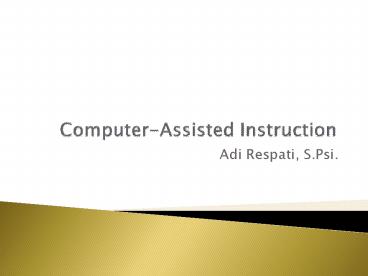Computer-Assisted Instruction - PowerPoint PPT Presentation
1 / 21
Title:
Computer-Assisted Instruction
Description:
Adi Respati, S.Psi. What Is Computer-Assisted Instruction? How do we design/implement CAI? How does CAI relate to e-learning? How CAI-ready are we? – PowerPoint PPT presentation
Number of Views:1780
Avg rating:3.0/5.0
Title: Computer-Assisted Instruction
1
Computer-Assisted Instruction
- Adi Respati, S.Psi.
2
Content Outlook
- What Is Computer-Assisted Instruction?
- How do we design/implement CAI?
- How does CAI relate to e-learning?
- How CAI-ready are we?
- What are the challenges of CAI implementations?
3
What is Computer-Assisted Instruction
- Role of computer in learning (Taylor, 1980) 1.
Tutor 2. Tool 3. Tutee - Role of computer in CAI Tutor
4
What is Computer-Assisted Instruction
- Patrick Suppes
- Laboratory for Learning and Teaching, Standford
University - Developed early model of CAI developed for
learning mathematics for elementary students
(1964).
5
What is Computer-Assisted Instruction
- CAI program (famous)CALL (Computer-Assisten
Language Learning) - Evolution of CALL evolution of CAI
6
What is Computer-Assisted Instruction
- CAI program (famous)CALL (Computer-Assisten
Language Learning) - Evolution of CALL evolution of CAI
7
What is Computer-Assisted Instruction
- CALL 1st generation Behavioristic CALL
- Behavioristic approach
- Learning through repetitions
- Performances are maintain with uses of
reinforcement - CALL 2nd generation Communicative CALL
- Communicative approach
- Learning began to be implicit
- Not in drill-format
- CALL 3rd generation Integrative/Explorative CALL
- shift of drill and tutorial purposes to
extending education beyond the classroom and
reorganizing.
8
How do we design/implement CAI
- Categories of Learning outcome
- Intellectual skills
- Problem solving
- Verbal information
- Motor skills
- Attitude
9
How do we design/implement CAI
- Categories of Learning outcome(Merrill et al.,
1996) - Intellectual skills
- Problem solving
- Verbal information
- Motor skills
- Attitude
10
How do we design/implement CAI
- What Tutor (CAI) applications do(Merrill et
al., 1996) - Computer presents information
- Students respond to questions/problems
- Computer evaluates
- Computer determines what to do next
11
How do we design/implement CAI
- Types of Application(Merrill et al., 1996)
- Drill and Practice
- Tutorial
- Simulation
- Problem-solving
- Games
12
How do we design/implement CAI
- Categories of Learning outcome
- Intellectual skills
- Problem solving
- Verbal information
- Motor skills
- Attitude
13
How do we design/implement CAI
14
How does CAI relate to e-learning?
15
How CAI-ready are we?
- Technological
- Computer literacy
- Information literacy
- Internet literacy
- -----------------------------------
- Psychological
- Anxiety
- Motivation
- Misperception on elearning at large
16
How CAI-ready are we?
- Students especially are more ready than todays
teaching staff. - --------------------------------------
- Students of Class of 2006 have been
internet-literate since their primary education - Their learning nature have probably much shifted
- Multimedia-based
- Contextual
- Hands-on
17
What are the challenges of CAI implementations
- Rise of Web 2.0(Wikinomics, Dan Tapscott,
2006)(Growing Up Digital, 2008) - Creative Common(Future of Ideas, Lawrence
Lessig, 2002) - --------------------------------------------
- Internet exposure (and offline culture)
emphasized in personalization - More resources are online more than ever
- Workplace offers the similar, more relevant
learning experience. - Rising collaborative nature in learningTrend of
sharing data, information, knowledge
18
What are the challenges of CAI implementations
19
What are the challenges of CAI implementations
- Rise of Web 2.0(Wikinomics, Dan Tapscott,
2006)(Growing Up Digital, 2008) - Creative Common(Future of Ideas, Lawrence
Lessig, 2002) - --------------------------------------------
- Internet exposure (and offline culture)
emphasized in personalization - More resources are online more than ever
- Workplace offers the similar, more relevant
learning experience. - Rising collaborative nature in learningTrend of
sharing data, information, knowledge
20
What are the challenges of CAI implementations
21
Sekian.





![Innovative Methods Computer Assisted Instruction [ CAI ] PowerPoint PPT Presentation](https://s3.amazonaws.com/images.powershow.com/6402049.th0.jpg?_=201504091211)

























